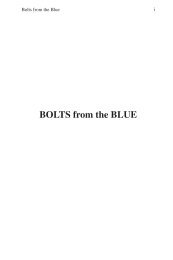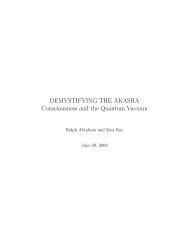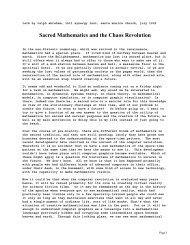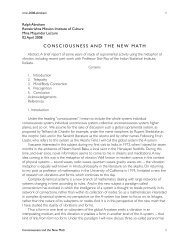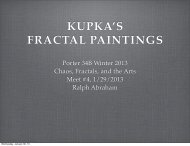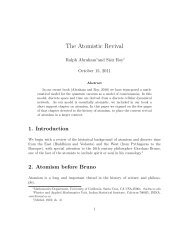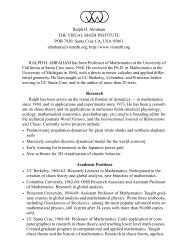Chapter 10. The chaos and fractals of Paris - Ralph Abraham
Chapter 10. The chaos and fractals of Paris - Ralph Abraham
Chapter 10. The chaos and fractals of Paris - Ralph Abraham
Create successful ePaper yourself
Turn your PDF publications into a flip-book with our unique Google optimized e-Paper software.
328 Bolts from the Blue<br />
compositions, an early form <strong>of</strong> Jazz. He was an eccentric composer<br />
in <strong>Paris</strong> by 1905.<br />
He meet Jean Cocteau (1891-1963) — French poet, dramatist,<br />
<strong>and</strong> leader <strong>of</strong> the literary avant-garde — in 1915. Serge de<br />
Diaghilev (1872-1929) directed a Russian ballet company<br />
which was popular in Europe before the First World War. Cocteau<br />
was a close friend <strong>of</strong> Diaghilev. In 1915, Cocteau was commissioned<br />
by Diaghilev, then in Rome, to write a ballet. <strong>The</strong><br />
idea for the ballet came to him in April <strong>of</strong> 1915, during a holiday<br />
from the front, after hearing a piano duet by Satie <strong>and</strong><br />
Ricardo Viñes. Cocteau enlisted Léonide Massine, the most daring<br />
<strong>of</strong> choreographers, Pablo Picasso, <strong>and</strong> Satie to work as a<br />
team on this project. Work began in the Spring <strong>of</strong> 1915, the scenario<br />
by Cocteau, choreography by Massine, <strong>and</strong> sets <strong>and</strong> costumes<br />
by Picasso, were created in Rome, while Satie began<br />
working in the spring <strong>of</strong> 1916 on the music at a cafe in <strong>Paris</strong>.<br />
<strong>The</strong> result, the realist ballet Parade, was produced at the<br />
Théatre du Châtelet in <strong>Paris</strong> on May 18, 1917, just as the Dada<br />
movement was getting underway. Revolutionary <strong>and</strong> shocking,<br />
it manifest Cubism in music, choreography, sets, <strong>and</strong> costumes.<br />
<strong>The</strong> audience rioted. Critics called the musical score — it called<br />
for revolvers, sirens, clappers, typewrites, lottery-wheels, Morse<br />
code keys, <strong>and</strong> so on — a 'mere din'. Progressing from order (an<br />
introductory fugue) to syncopation (inspired by Ragtime) to<br />
<strong>chaos</strong> (a frenzied dance finale), the musical score now suggests<br />
the bifurcation diagram <strong>of</strong> the logistic function basic to <strong>chaos</strong><br />
theory, <strong>and</strong> the <strong>fractals</strong> <strong>of</strong> Julia <strong>and</strong> Fatou as first shown in computer<br />
graphics by M<strong>and</strong>elbrot. Appolonaire's review <strong>of</strong> the ballet<br />
coined the word surrealism to describe the revolutionary<br />
ballet.<br />
<strong>The</strong> team worked together again to produce the ballet Mercure,<br />
first preformed in <strong>Paris</strong> in 1924, after the Dada movement<br />
had been replaced by Surrealism. This ballet included twelve<br />
principal scenes, one <strong>of</strong> which is actually called Chaos. Satie's<br />
score for this scene combined the themes <strong>of</strong> two earlier (<strong>and</strong><br />
very disparate) scenes to suggest <strong>chaos</strong>, which is surprisingly




